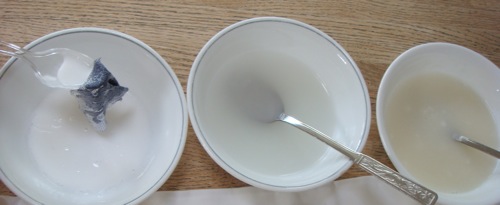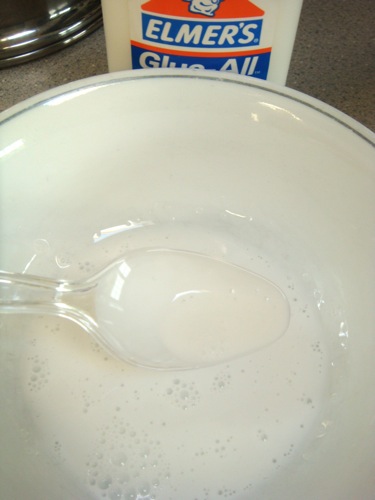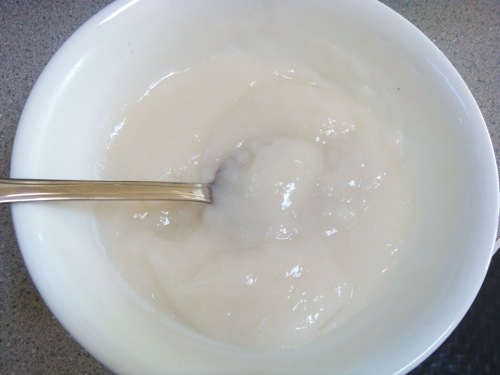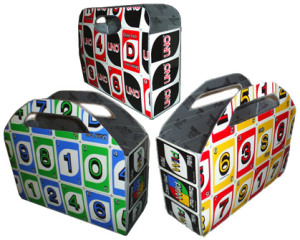
Check out these natural fabric stiffeners made with common household ingredients, along with the pros and cons for each one!
When I made this fabric box with burlap, I used fusible web to stiffen the sides. But I wanted to find out what natural fabric stiffeners would be like. So I tried three stiffening methods using common household ingredients.
The idea for natural fabric stiffeners came to me when I read Julie’s homemade spray starch and natural glue tutorials and I wondered if I could modify the formulas to use them as fabric stiffeners.
I tested three ingredients for stiffening: Elmer’s Glue, cornstarch, and flour. Here’s what I found out:
1. Elmer’s Glue All As a Natural Fabric Stiffener
Equal parts of glue and water.
Elmer’s glue is listed as being non-toxic and safe on its label and on the Material Safety Data Sheet (MSDS). But the ingredient is still a type of plastic – polyvinyl acetate, to be exact. So while it’s labeled as being safe, I don’t think I’d eat it. In order to mix the solution, I used a glass bowl that I wouldn’t use for eating and an old plastic spoon. The mixture is solid white and it dried as clear film. The residue comes off clean with warm water and soap.
2. Cornstarch Natural Fabric Stiffener
1 Tbsp, 1/4 C cold water, and 1/4 C boiling water.
Dissolve 1 Tbsp of cornstarch in 1/4 C cold water. Meanwhile, boil 1/4 C of water. Slowly, add the cornstarch solution to boiling water and whisk and boil until the solution bubbles. Take the solution off the heat and cool to room temperature before using.
The consistency is thick, like Tapioca pudding. It is translucent and dries clear. Since it’s cornstarch, there is no concern whether it’s toxic or not. I didn’t have to use separate pots or bowls to make this solution. After I was done, I washed them with warm soapy water and they were safe to cook with afterwards.
3. Flour Starch Natural Fabric Stiffener
1 Tbsp, 1/2 C Cold Water, and 1/2 C Boiling Water
Mix 1 Tbsp flour with 1/2 C Cold water. Boil 1/2 C of water in a small pot. Briskly whisk the flour mixture into the boiling water. When the consistency become thick, like gravy, take the pot off the heat and let it cool to room temperature. If you need to stiffen a larger fabric piece, make a bigger batch using this ratio and dunk the whole piece.
As time goes by, the mixture becomes more goopey. You can add more water if you need a thinner solution. The color is “linen white” and not “ceiling white.” If you are stiffening white fabric or lace, it may not be bright white after it dries.

These are the three different types of natural fabric stiffeners, from the left: Elmer’s Glue/Water, cornstarch, and flour starch.
As you can see they resulted in three different colors. If you need to stiffen white fabric or lace, the Elmer’s Glue or Cornstarch methods might be the best to maintain the whiteness.
Want to make your project more vintage-y looking? The flour method will be fine. Since Elmer’s Glue is not exactly “natural”, you may need separate equipment to use this method. However, the Elmer’s Glue method would make the stiffness last longer. It takes repeated washings before it gets soft. Cornstarch and flour method wash off easier, making stiffness not as long lasting.
I could have tried the rice method as my grandmother used to use rice water as starch spray when I was growing up. But as we no longer eat white rice, I didn’t have any on hand to experiment with. But it works great as starch spray so I presume it works well as a stiffening solution like cornstarch and flour. But the only drawback is that you have to boil white rice for a long time with a copious amount of water until you get a thick consistency.
Check out Crochet Memories for more stiffening methods.
Which method are you going to try?












Have you heard of Dip and Drape ? About 25 years ago I used this product to make several characters such as a nativity set, santas, angels and carolers. I’m really trying to locate the patterns for these because I think I would be able to use some of these other methods of fabric stiffiners. Please let me know if you have any ideas. Thanks
I need to stiffen some fabric and I am going to use UNIBOND but I am in England as I guess you are not ?
No, I’m not. Tell me all about Unibond!
Dip fabric into pva glue. If the product is already made pour glue on it.
Thinned gesso, and/or any of the above will work. For a hard finished drape, hanging moist, and adjusting until satisfied, and too stiff to work with. A water spray bottle to extend working time.
i am also looking for dip and drape
any info would be helpfull
We replaced the Dip and Drape with watered down school glue (which dries clear) for our group projects to save the expense and it worked perfectly.
Can any of this stiffening procedures be used on dark fabrics (polyester) without leaving white marks?
How long can it be stored and is there a way to preserve a large volume for later use at room temperature?
Pingback: How to make burlap ornaments {Guest Post} | A green living, green parenting blog
Please help me find patterns for Santas and Mrs. Claus, etc.
I’m wondering about the durability of the 3 stiffeners. How did they hold up? Which would you recommend for areas with high humidity in summer? Thanks for the info.
that’s what i’m wondering.
High humidity can cause the flour version to mold. Back in the day, people used flour water to put up wallpaper. In too many cases removing old wallpaper showed mold in the walls caused by the flour paste. There is a reason why wallpaper pasted was developed.
If you don’t heat the cornstarch version fully dries, the cornstarch will start to come off leaving a powdery residue. This one is the least stable of the three and really isn’t a good interfacing substitue. Commercial corn starch based spray starches require heating and stabilizers added to keep it from, basically, coming apart.
As all of these contain starches, all of them have the possibility of drawing insects. So you’d want to wash your project when you’re done creating it…which defeats the purpose of using them as a permanent interfacing.
That being said, I don’t like using modern interfacings, fleeces, etc., but have yet to find a viable alternative. I am going away from adhesive ones and either basting in the interfacings or using Elmer’s glue knowing I’ll have to wash the creation afterwards. I wash duck cloth and use that as a stiffener but sometimes I need more in my projects as duck cloth isn’t as stiff as I need it to be.
for a more natural stiffener, mix a paste of rice flour/potato flour/corn flour. ..all natural, non-toxic and works a treat!
For my final runway project I was looking for natural ways to stiffen fabric, so your post was really helpful. I’m probably going to use the second option due to the clearness after drying.
Thanks, Gennie, I’ll try this ! You see how often I check my mail !
If you wash any fabric that has been stiffened using the above solution – does it wash off? or does the stiffness remain? I’m looking for something permanent.
Thanks!
Thanks for the comparison of the three major methods. Very helpful!
I use potato flour. It’s completely white. My mother used it too. It’s natural and I don’t think I even considered using anything else to stiffen fabric, especially embroidered pieces.
I need to freshen or smarten up the kids’ school uniforms. I have about 30 knit shirts to bring back to life. Can I throw a large batch of this solution into the washing machine and do the whole lot at once? Would the Elmer’s glue method work best for this?
I’m not sure any of these would work for that, since they wash out. Are you trying to get stains and whatnot out?
These fabric stiffeners are meant more for home dec uses, such as making fabric baskets stiff or stiffening lace doilies for display. For clothing, I think you’d be better off with spray starch, as in this tutorial:
http://craftingagreenworld.com/2011/03/06/how-to-a-simple-recipe-for-d-i-y-laundry-spray-starch/
Idk how it would work in the washing machine, but i starch my jeans, regularly and spray starch just wasn’t getting them as stiff as I wanted(think it’s an Texas thing, if they aren’t able to stand up on their own, it just won’t do) lol. So I’ll tried very watered down elmers glue and it works AMAZING!!! Doesn’t hurt the fabric one bit
Well that’s interesting. I wouldn’t want to wear those,. Sounds uncomfortable to me.It takes all sorts to make a world.
It would be quite a boring world with only Lynne Harris(es) in it.
As I am an avid sewer of both apparel and quilts, was very interested in your “Fabric Stiffener” article. I tried printing it out
to reference it at later dates. However, the print was so light that
I would never be able to use it. Can you suggest an alternative that I can use?
That’s a good question! I passed your problem on, and our tech person boosted the contrast of our text, so hopefully it should print dark enough for you now. If it doesn’t, tell me and we’ll figure something else out for you.
It’s easy enough to copy and paste the text of the web page into a word file, then select the word document and make sure the font color is black.
trying to make a small pouch like clutch and think i will need to stiff up the fabric. i read about the one with glue… but wondering if i should tread the fabric before i start the sewing process…. or after? and just how stiff is the glue method… will fabric be as stiff as a “stick”? or will it still have some “movements” when you carry it?
I making a activity book for my grandkids. The pages are blue & purple. Will the cornstarch be the best method? Will the fabric show white though it? The pages have pictures & words that is sewn on. Any suggestions.
Hrrrmmm… I don’t know if cornstarch would be the best method, because I always wash mine out later. If you want the pages themselves stiff, I’m wondering about interfacing. Batting would work, or you could sew in something stuff but washable, like plastic sheeting.
Thanks so much – Absolutely what I needed. (I was making a fascinator and the tulle was too flimsy. Used the cornstarch recipe and it worked great 🙂
As I live in Florida, I believe I will try the glue first to stiffen a crochet basket because I’d like to discourage any of our natural creatures from finding it edible!
I am trying to make a Ghost Baby. It will set outside on a covered porch, but at night it gets damp. I have went through a whole can of fabric stiffener and the night air softens right back. This fabric mgeeds to stand up on its own.please help
Hmm, that’s a tough one! Humidity is going to soften up anything, because the wetness is the same as if you were washing the stiffener out. You might try a very thin solution of plaster of Paris, which *might* give it the stiffness that you need without sacrificing the translucency that you want.
curious…what’s a ghost baby?
I’m looking to stiffen a black masquerade mask so I can place it on a dowel to hold up to my face. This mask is some what flimsy because its suppose to be tied around your face. Suggestions on which method would be best for this and black material? Thanks.
I think that soaking it in a liquid starch solution, or perhaps even in something like Elmer’s glue, might be necessary to make it as stiff as you need.
I tried the corn starch method and it worked great. I’ll have to try once more and not be so liberal with application (I got a little too excited!). I used it to stiffen bandannas for a project and it made them a little dull. Either use less mixture or thin out mixture. We shall see!
After using any of the natural stiffeners mentioned above, is it safe to wash the material the stiffener is used with ?
Or it being that it is natural it may disintegrate ?
Would this work on Nylon. I want to make some hair bows from a pair of leggings and need to stiffen the fabric a bit so its not to flimsy.
My cat got something onto a snowflake I made and stiffened…is it safe to wash after stiffening it? (probably will reapply stiffener after…)
If the fabric is washable, I don’t see why you couldn’t at least hand-wash it. And yes, the stiffener would definitely need to be reapplied, but it shouldn’t fray or warp if you hand-wash. You might want to spot-test, though, or apply stiffener to scrap fabric and then try to wash that?
Many moons ago I used a very rigid stiffener for a cotton crocheted basket. The stiffener was made from sugar dissolved in boiling water .. lots of sugar .. lots of starch on basket shape ..worked well .. kept rigidity and shape for years until time to wash and start again.
OK, don’t laugh, but… How do you actually apply the cornstarch mixture to the fabric? Dump the fabric in it, brush it on, or?
I treat it like spray starch and spritz it on from a spray bottle. I have heard of people soaking the fabric in it, as well.
I am crocheting a sun hat .what is the best way to stiffen the yarn after the hat is done?
Amazing…I can’t wait to try this on Cornstarch methods
I have a costume for Halloween and it has a neck piece that needs to stand up but the fabric is sort of like silk on the front then polyester on the back. Would one of these work with stiffening it to stand up around the neck or turn the black polyester white and flaky?
How do these compare to the Powertex and Paverpol?
I would like to have the answer to this question above about Paverpol and to Powertext as well. I am thinking of stiffening the fabrics on a sculpture of a woman using PVA glue or Elmers glue? Would this work?
Just finished a paverpol statue late Sunday it’s drying having paid twenty five dollars for the small container decided to use only half of it then completed it using straight Elmer’s glue all. When making Christmas deorations using burlap I stiffened very large pieces of it using Elmer’s glue all with just a very very little water. The burlap was so stiff I had to buy heavy duty scissors to cut it. after making my deco pieces I sealed everything with krylon clear sealer which I have used for many years. It protects the item for years and years.
by the way upon opening up my tub of paverpol and smelling it was exactly like smelling my gallon of elmer;s glue all. take small pieces of fabric use different amounts of water to find out the stiffning you want. Made some fasinators with flimsy fabric and Elmer’s came out beautiful. God bless All keep on creating, it’s a wounderful thing. been at it a very long time just loving it.
would the cornstarch method work on crafting tulle? I am trying to make troll hair headbands for party favors.
Can you tell me which one of your three methods did you think worked the best please?
What if the starch paste didn’t dry clear? How do I fix it on my item?
I have a sun hat made of a light canvas. I want to give it some shape so which process would you suggest to last the longest?
Pingback: Make your own ephyra! – Well Read Panda
Pingback: Make your own radiolarian! – Well Read Panda
Interesting. I found a reference to fabric drawer liners on the Nalle’s House blog. I was wondering about permanent vs temporary options. I wonder if my PVC/hodge podge reciple would be suitable, just wash and iron the fabric then paint it with 1cup water to 1/3 cup PVC glue.
What are your thoughts? Is it better to make fabric liners as washable as possible? I love putting away my washed clothes and desk bits and pieces neatly. It’s probably some kind of sickness, but t least I don’t sort my clothes alphabetically (just be type and colour 😉
facebook.com/ZakkaWithAli
I found that Paverpol leaves a yucky residue on my wool felted creations – even when diluted a lot. This may be because wool has lanolin in it and is hard fo het the paverpol soaked through it?
I found that if I used a paper towel or cloth to draw out the excess water the residue dissapeared and left just the stiffener behind.
can you paint the stiffen product..
I needed to starch the cuffs on my shirt and since I have no flour or corn starch on hand, I tried the glue/water method. After testing, it needed to be thinned. So basically, 2 parts water/1 part glue worked perfectly for ironing. Thanks for the great ideas!
Hi, once you have the solution made how do you apply to the Material? I’m wrapping presents o
In material but it’s very slippy material so thought this may help stiffen it
I want to stiffen the brim of a straw boater to make it solid
Hi, very informative! I was wondering if I can use either of these methods for stiffening macrame feathers?
Hello, wondering if I use cornstarch or potato starch to make fabric stiffener ( I need it for some crocheted Christmas trees I want to gift at Christmas) is there a danger of the starch rotting with time?
I wonder if they work…. I shall try em.
Any other options for a spray stiffener?
Made the cornstarch stiffening for star ornaments I crocheted. It’s a bit messy to dip them in and then remove the excess AND then try to pin them down onto a piece cardboard to form their shape, but it will be so worth it once they dry! And now this years ornaments, that I give to family, is almost done!!! YAY! Thanks for the recipe!
~Dolores
Would this work to stiffen a floppy rope basket?
has anyone tried the flour/water solution to adhere layers of fabric temporarily? I know that flour/water used to be used as glue back in the day.
In case its helpful for anyone, I used the regular flour and water method to stiffen crocheted stars for Christmas ornaments. They were made with a red yarn and there was a slight dulling of the colour but no white residue or anything like that. I’m very happy with the results and all non toxic!!